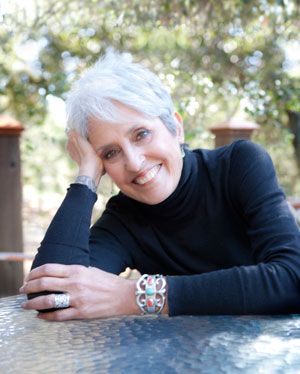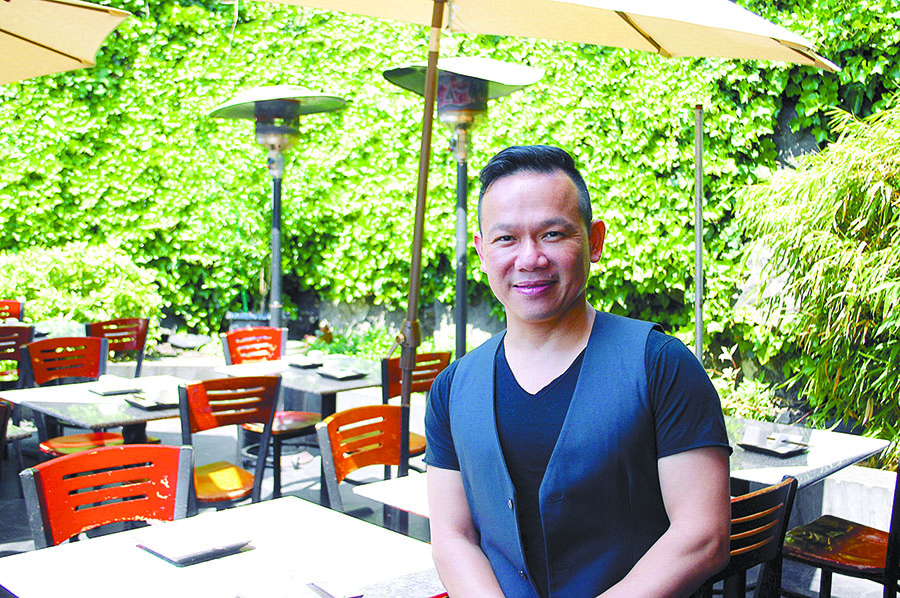Like an old familiar friend, Joan Baez appeared on stage Friday evening at The Moore Theatre, and for 105 enchanting minutes she ushered a decidedly older crowd back to a time when there was music in the cafes at night and revolution in the air, as a famous old lover of hers wrote and sang decades ago.
There she stood in blue jeans, soft black boots, and a long red shawl, St. Joan, 73 years old (impossible to believe), her hair short and silvery as a newly minted dime. With a goofy, sweet smile, Baez, one of the country’s greatest folk singers and balladeers, tickled her adoring audience as she recounted a young waitress at her Seattle hotel who, while serving the famed singer and her small entourage breakfast, noticed on the dining table a backstage pass with Baez’s name on it, and asked innocently, “Oh, Joan Baez, is she still alive?”
In a soprano voice tempered by time, but still a formidable instrument, Baez sang Phil Ochs’s “There But For Fortune,” which she recorded in 1964. “Show me the country where the bombs had to fall,” she strummed to the crowd’s delight. “Show me the ruins of the buildings once so tall/ And I’ll show you a young land with so many reasons why/ And there but for fortune, may go you or I.”
Accompanied by a two-piece ensemble, Baez later swelled the Belltown concert hall with a haunting recitation of Bob Dylan’s “It’s All Over Now, Baby Blue.” In tones, clear as crystal, she unloosed those bewitching lyrics that Dylan laid down in 1965: “Leave your stepping stones behind/ Something calls for you/ Forget the dead you’ve left/ They will not follow you/ The vagabond, who’s rapping at your door/ Is standing in the clothes that you once wore/ Strike another match, go start anew/ And it’s all over now, Baby Blue.” The crowd cheered, long and loudly, greedily inhaling the hearty meal of nostalgia Baez gratefully served.
Baez, who for years has kiddingly regretted sharing a January 9 birthdate with Richard Nixon, burst onto the national music scene at the 1959 Newport Folk Festival, where she mesmerized crowds with her heart-wrenchingly gorgeous a cappella version of “We Shall Overcome.” Judy Collins wrote in her 2011 memoir Sweet Judy Blue Eyes: “Her performance was otherworldly, startling, unlike anything folk music fans had known.”
Three years later, in 1962, Baez would appear on the cover of Time magazine, her long dark hair spilling down upon her acoustic guitar. This was the beautiful barefoot troubadour, after all, who in the early 1960s was emulated by the likes of Joni Mitchell, Emmylou Harris, and Bonnie Raitt. It was Baez, many forget, who introduced her audiences in New York clubs to the then-unknown Dylan, “the original vagabond [who] strayed into my arms,” as she later composed as part of “Diamonds & Rust,” Baez’s signature anthem of her love affair with Dylan a half-century ago.
On this cold Friday night, Baez provided warmth and comfort to her aging admirers, many of whom paid, without hesitation, more than $100 for the best seats. Throughout her recital, the sheer loveliness of her voice was as smooth as the white silk blouses she wore to almost every performance in the 1960s and ‘70s. As
New York Times music critic Stephen Holden wrote in 2008 of her career retrospective, celebrating her 50th year in show business, “You want to rest your head on her lap and be soothed by the sound of the cosmic lullaby emanating from within.”
Baez sang one of her own creations, “Lily of the West,” before moving on to “I Need You Just the Way You Are.” Tears welled in the eyes of some as she tenderly crooned Donovan’s classic “Catch the Wind,” its melody as gorgeous as a first snow: “For standing in your heart/ Is where I want to be and long to be/ Ah, but I may as well try and catch the wind.” Again, the crowd let forth a passionate cheer and Baez smiled, for it was clear she was enjoying herself.
She went on to sing “House of The Rising Sun,” made famous by The Animals, then a breathtaking rendition of “Swing Low, Sweet Chariot” (which Baez performed in a pouring rain at Woodstock on Aug. 15, 1969), and a snappy toe-tapping version of “Nine Pound Hammer,” long a bluegrass staple in which she charmed the crowd with an impromptu foxtrot with a band member.
“Now,” she announced, “I am going to do ‘God On My Side.’ It is one of the best antiwar songs ever written. I wish I had a written it,” and then quickly (and playfully) sniffed, “Dylan wrote it.” The chilling words poured out, rich with power and certainty: “In the nineteen-sixties came the Vietnam War/ Can somebody tell me what we’re fightin’ for?/ So many young men died/ So many mothers cried/ Now I ask the question/ Was God on our side?”
Baez was closing in on the end of her night when she began to sing the song everyone fully expected, “Diamonds & Rust,” and would have been deeply disappointed had she not. The seminal tune was recorded in 1974 and released in a gold-selling album in 1975, the same year Dylan’s Blood on the Tracks—arguably his greatest work—also stole fire from heaven. Baez belted it out. “Fifty years ago,” she sang, changing the lyrics from it’s original “10 years ago” with cheerful defiance, “I bought you some cuff links/ You brought me something/ And we both know what memories can bring/ They bring diamonds and rust.”
The crowd was on its feet now, pleading for an encore. Baez obliged, first singing John Lennon’s “Imagine,” and proceeding, after yet another beseeching roar, to Paul Simon’s “The Boxer,” to which she sang with a determined fierceness that declared, “I’m still here, dammit. It’s not all over yet, Baby Blue.” And her voice rang out: “In the clearing stands a boxer/ And a fighter by his trade/ And he carries the reminders/ Of ev’ry glove that laid him down/ And cut him till he cried out/ In his anger and his shame/ ‘I am leaving, I am leaving’/ But the fighter still remains.”
Baez, ever the fighter, at last bid an affectionate farewell, bending her head sideways into her hands to signal it was time for her to go beddy-bye. Fittingly, she chose as her final number of the night the Dylan-written “Forever Young.”
St. Joan sang it loud and clear, hitting and sustaining the high notes, as if just to prove she could: “May your hands always be busy/ May your feet always be swift/ May you have a strong foundation/ When the winds of changes shift/ May your heart always be joyful/ And may your song always be sung/ May you stay forever young/ Forever young, forever young/ May you stay forever young.”
Same to you, Joan Chandos Baez.
Note: A few days before Joan Baez’s Seattle performance, my talented colleague at Seattle Weekly, Gwendolyn Elliott, conducted a wonderful interview with the famous songstress. Gwen covered a great deal with her, gauging Baez’s insights on what social issues most concern her, the goings-on in Ferguson, Missouri, and her thoughts on what might be the role today, in this digital age, of protest music. I highly recommend it. Click
here to read
.








